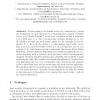Free Online Productivity Tools
i2Speak
i2Symbol
i2OCR
iTex2Img
iWeb2Print
iWeb2Shot
i2Type
iPdf2Split
iPdf2Merge
i2Bopomofo
i2Arabic
i2Style
i2Image
i2PDF
iLatex2Rtf
Sci2ools
FUN
2010
Springer
2010
Springer
On Table Arrangements, Scrabble Freaks, and Jumbled Pattern Matching
Given a string s, the Parikh vector of s, denoted p(s), counts the multiplicity of each character in s. Searching for a match of Parikh vector q (a “jumbled string”) in the text s requires to find a substring t of s with p(t) = q. The corresponding decision problem is to verify whether at least one such match exists. So, for example for the alphabet Σ = {a, b, c}, the string s = abaccbabaaa has Parikh vector p(s) = (6, 3, 2), and the Parikh vector q = (2, 1, 1) appears once in s in position (1, 4). Like its more precise counterpart, the renown Exact String Matching, Jumbled Pattern Matching has ubiquitous applications, e.g., string matching with a dyslectic word processor, table rearrangements, anagram checking, Scrabble playing and, allegedly, also analysis of mass spectrometry data. We consider two simple algorithms for Jumbled Pattern Matching and use very complicated data structures and analytic tools to show that they are not worse than the most obvious algorithm. We also sh...
| Added | 19 Jul 2010 |
| Updated | 19 Jul 2010 |
| Type | Conference |
| Year | 2010 |
| Where | FUN |
| Authors | Peter Burcsi, Ferdinando Cicalese, Gabriele Fici, Zsuzsanna Lipták |
Comments (0)

